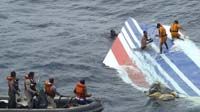
The French Accident Investigation Bureau (BEA) Thursday released its final report on the 2009 crash of Air France Flight 447, an Airbus 330 that went down off the coast of Brazil in 2009, killing all 228 aboard. Among the report’s conclusions are that neither of the two copilots flying the aircraft called for the “unreliable IAS” procedure after pitot icing led to the loss of airspeed indications. Neither pilot had training for hand flying the jet at high altitude, according to the report, or for flying with questionable airspeed indications. “Inappropriate pilot inputs” led the jet to “exit its flight envelope” less than one minute after the autopilot disconnected and before the captain returned to the flight deck from his rest station. The report faults the pilots’ actions and also finds that their training met regulatory standards. There may be other implications for regulatory agencies, Airbus and Air France regarding their pre-existing knowledge of shortcomings in the aircraft’s pitot system.
Loss of airspeed data during the event was attributed to icing of the pitot probes. Airbus and Air France had recognized deficiencies in the probe prior to the crash and began modifications to aircraft (that included new pitot equipment) on May 30, 2009. The loss of Air France Flight 447 took place two days later, on June 1, 2009. The report states that “EASA had analyzed pitot probe icing events; it had confirmed the severity of the failure and had decided not to make the probe change mandatory.”
During the accident, a stall warning sounded continuously for 54 seconds.According to the BEA report, the Airbus A330 only exhibits buffet on the approach to stall.The pilots made no reference to the warning, the “appearance of buffet,” or the stall suffered by the aircraft. BEA notes that the aircraft’s angle of attack is not directly displayed to its pilots. The report concludes that the conditions of flying at high altitude in turbulence “led to excessive handling inputs in roll and a sharp nose-up input by the pilot flying.” It goes on to say that, “In the minute that followed the autopilot disconnection, the failure of the attempts to understand the situation and the de-structuring of crew cooperation fed on each other until the total loss of cognitive control of the situation.” The last recorded values of pitch attitude were 16.2 degrees nose-up with a roll of 5.3 degrees left and a vertical speed of negative 10,912 feet per minute. Find the full text of the BEA final report online (PDF).


































